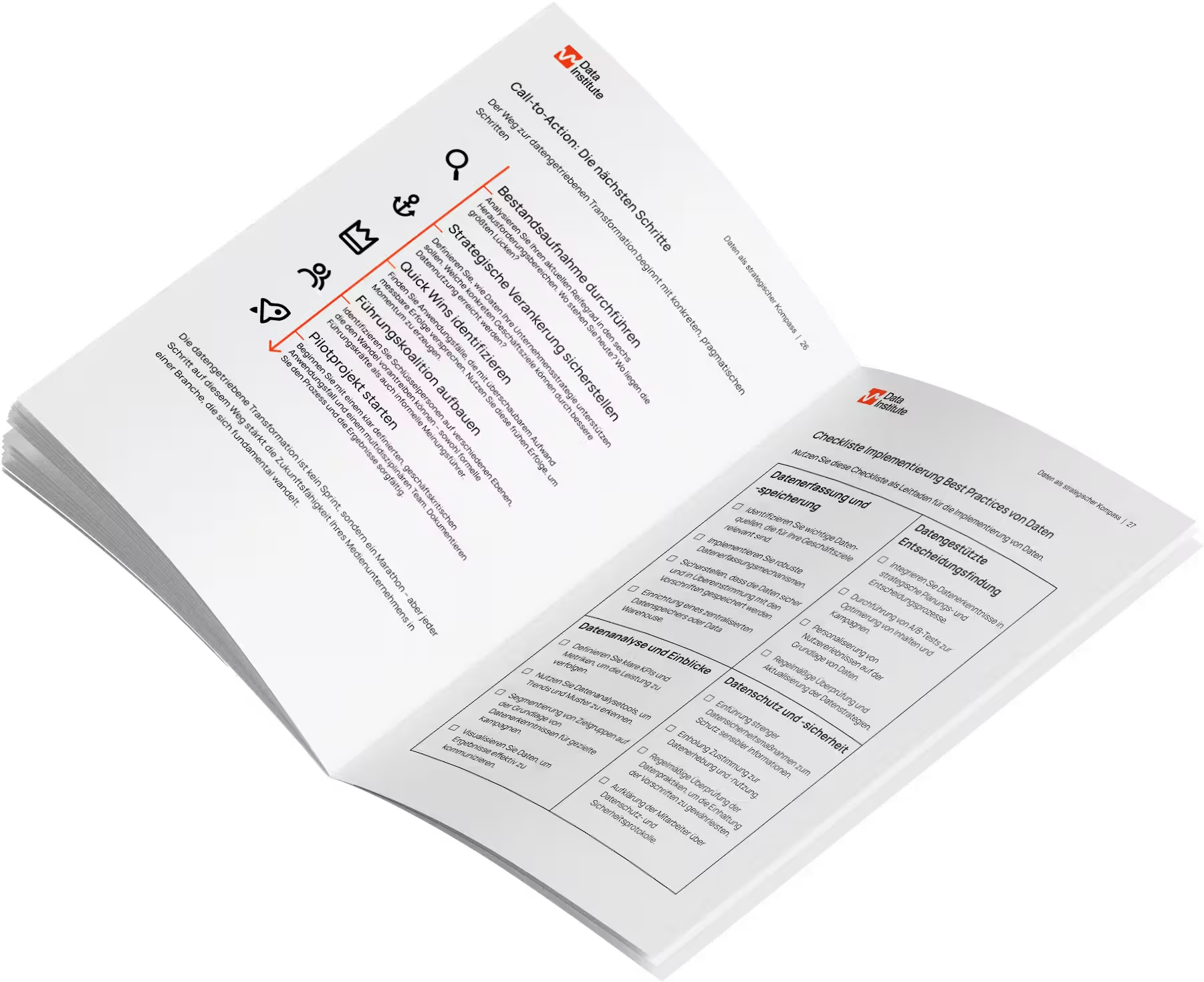Data Governance: Framework for data-driven success


The roadmap for data-driven transformation
The ePaper shows you strategies, success stories and a checklist for a direct start into the digital future.

- Das ist eine H2
- Das ist eine H3
In an increasingly data-driven world, data governance plays a central role in the success of companies. Our original articles already stress the importance of data governance for improving data quality (see Data Governance in SMEs), minimizing risks and making decisions. This revised blog post broadens this perspective, integrates new insights, and provides comprehensive guidance on how to establish a robust data governance framework.
What is data governance?
Data governance is often jokingly referred to as “police” in the data scene. However, this analogy is too brief, because it is not just a matter of monitoring rules, but above all of setting them. Data Governance is a comprehensive approach that includes the principles, practices, and tools for managing an organization's data assets across their entire life cycle. It is a collection of processes, roles, policies, standards, and metrics that enable effective use of information and help organizations achieve their goals.
The concept ensures that data is accurate, accessible, consistent, and protected. It defines who can use which data in which situations and with which methods. Ultimately, data governance serves to recognize data as a valuable resource in the company and to treat it accordingly in order to make it usable for business and IT goals.
Why is data governance important? The benefits and business objectives
An effective data governance strategy offers companies numerous benefits and is essential to unlock the full potential of data as a critical asset.
1. Improved data quality and reliability: Data governance ensures that data is accurate, complete, up-to-date, consistent, and reliable. Without a solid framework, companies risk faulty data analyses and inefficient business processes. High data quality is crucial for precise analyses, well-founded decisions and cost efficiency. By setting standards and implementing quality controls, data quality is continuously monitored and improved.
2. Lower risk and higher safety: Data governance helps to significantly minimize risks associated with data misuse, security breaches, and compliance breaches. It implements robust security measures such as encryption, firewalls, and access controls to protect sensitive data from unauthorized access. This protects the corporate image, prevents possible financial and legal consequences and strengthens customer trust. data ethics plays a fundamental role in this by making privacy and compliance with data protection laws (such as the GDPR) a top priority.
3. More efficient decision making and higher productivity: By ensuring a uniform data base (“single source of truth”) and avoiding data silos, data governance enables employees to quickly and easily access necessary, trustworthy information. This reduces time-consuming manual searches and errors, increases productivity, and enables more informed, data-driven decisions.
4. Improved collaboration and increased data value: Clear guidelines and processes for sharing data improve collaboration between departments. When everyone follows the same data standards, communication becomes smoother and misunderstandings are reduced. This promotes knowledge transfer, a better data culture and leads to more innovation, better decisions and maximum added value from the data.
5. Ensuring compliance and building trust: Data governance enables continuous compliance with legal requirements such as GDPR, HIPAA, and industry-specific standards. This is not only a legal obligation, but also helps to strengthen consumer confidence. Companies must be accountable for how they collect and process data, which includes ethical standards and control mechanisms.
6. Offensive and defensive aspects: Data governance enables companies to act both offensively and defensively.
- Offensive means democratizing data, promoting efficiency through data use, and developing data-based business models.
- Defensive includes measures to avoid adverse events such as fines, fines or negative consequences due to failure to comply with compliance, ethics and data protection.
Let us talk about your goals and challenges, learn more about our Data Governance Consulting.
Data governance is NOT... (delimitation)
It is important to differentiate data governance from closely related concepts to avoid misunderstandings.
- Data governance is not data management: While data management involves managing the entire life cycle of data within an organization (including collection, integration, organization, transformation, and archiving), data governance is the central component of data management. Data governance defines corporate policies and frameworks to align data-related requirements with business strategy, while data management is the operational aspect of implementing that strategy.
- Data governance is not Master data management (MDM): MDM focuses on identifying key areas of an organization and improving the quality of this data (e.g. customers, suppliers). It balances fragmented views in a central view, which goes beyond data governance. Data governance provides the framework within which MDM and other data management disciplines operate.
Key elements and pillars of data governance
A robust data governance framework is based on several key pillars that contribute to data integrity and usability.
1. Data Governance Framework and Principles: The framework defines the basic principles, guidelines, and processes for corporate data governance. It ensures that all decisions related to data are made on a solid basis, which strengthens the consistency and integrity of the data. Key principles include:
- Transparency: Clarity about the existing data sets and their use vis-à-vis internal employees and customers creates trust. This includes disclosing what data is collected, what it is used for and where it is stored.
- Responsibility: Companies must ensure that there are no “data gaps” where no one is responsible. Clear definitions of data and the allocation of responsibility to relevant stakeholders are crucial here.
- Integrity: It's about how “good” your data is. The data catalog must be accurate, relevant and up to date and comply with the guidelines. A culture of honesty about data processes and maintaining the highest possible data quality is essential, especially when training AI models.
- Collaboration: Effective data standards can only be achieved through cross-departmental cooperation. The ability to exchange data via an intuitive data catalog promotes this.
2. Data quality: Data quality is a central aspect of data governance and measures the extent to which data sets meet the requirements and expectations of their intended use. High data quality is crucial for reliable analyses and decisions. Key dimensions of data quality include completeness, integrity, consistency, validity, accuracy, and timeliness. Data quality measures include data profiling, cleansing, standardization, enrichment, and validation. This is an ongoing, iterative process that requires data quality management across the entire data life cycle.
3. Data security and compliance: Protecting sensitive data and complying with regulatory requirements is a top priority. Data governance reduces security and privacy risks by implementing controls and processes to prevent unauthorized access and misuse. This includes data classification based on sensitivity and importance, access controls that determine who can access which data, and regular reviews of data permissions and access.
Laws such as the General Data Protection Regulation (GDPR) in the European Union set strict rules for the collection, processing, and storage of personal data. Data governance ensures that companies comply with these and other international standards and guidelines, such as ISO or OECD.
4. Roles and Responsibilities: Clear roles and responsibilities are essential for managing data. A Data Governance Team is responsible for implementing and monitoring the strategy. Specialized positions include:
- Data owner: Responsible for the accuracy and quality of the data of a specific data object.
- Data Steward: Responsible for monitoring data quality, managing metadata, and ensuring compliance with data policies.
- Data consumer: The end users who use data for their daily tasks.
- Chief Data Officer (CDO): A management position that drives data governance in the company and often chairs a data governance committee.
- Data Curator: Actively involved in day-to-day business to intervene in case of data quality problems.
5. Data processes and life cycle: Standardised processes are essential for collecting, storing, using, archiving and deleting data. These processes must be adapted to the specific needs of the company and regularly reviewed and optimized to comply with current best practices and technological developments. This applies to the entire data life cycle (“data lifecycle”).
6. Data cataloging and data discovery: A Data catalog serves as a central metadata repository for a company's data assets. It enables actors to quickly find, understand and retrieve the data they need, which the Data democratization accelerates and unlocks the actual added value of the data. The catalog also helps identify potential data quality issues through data profiling and origin.
7. Data origin (data lineage): Die Source of data is a powerful tool that helps companies ensure the quality and credibility of data by providing a better understanding of data sources and data usage. It captures relevant metadata and events across the entire data life cycle and provides seamless insight into the data flow.
8. Data sharing and collaboration: Secure mechanisms for data exchange and collaboration are essential in the modern business world, both with internal teams and with external partners and customers. Data governance ensures that this is done while maintaining control and overview over the use of sensitive data, for example by using Data cleanrooms.
9. Technology Support (Tools & Infrastructure): Technical tools can automate and support data governance processes. This includes features for data cataloging, metadata management, data quality monitoring, and access control. Modern data governance solutions are often based on a Data lakehouse architecture built that combines the best features of data warehouses and data lakes to address all data, analytics, and AI use cases on a single platform. Examples of tools include Astera, OneTrust Data Discovery, or the integration of Dataplex with BigQuery.
If you need help with these complex core elements of data governance, learn more about our Data Governance Consulting.
Implement a data governance strategy
Implementing data governance is an iterative and continuous process that requires patience and continuous adjustments.
1. Define strategy and objectives: Start by defining a clear data strategy that aligns with the company's overall goals and vision. Identify key stakeholders and data needs. This includes both offensive (e.g. data monetization) and defensive goals (e.g. compliance).
2. Identify current situation and weak points: Evaluate the current state of data management, existing technologies, human resources, and processes. Identify strengths, weaknesses, and gaps that hinder goal achievement. This analysis often reveals existing weaknesses in systems and business processes.
3. Develop a data governance framework: Create a framework that defines the principles, policies, and processes for data governance. This should include specific goals and a roadmap for implementing the required processes and technologies.
4. Establish and assign roles and responsibilities: Define clear roles and responsibilities, including data owner, data steward, and data consumer. As an example, the assignment can start in a department in order to show the added value and break down barriers.
5. Develop and integrate data processes: Establish standardized processes for the entire data life cycle (collection, storage, use, archiving, deletion). Integrate data quality into all policies and procedures, from data collection to use.
6. Set data quality goals and metrics: Define what high-quality data means for your company (accuracy, completeness, consistency, timeliness, relevance). Then set metrics to measure data health and track improvements.
7. Implement tools: Implement technical tools to automate and support data governance processes. This can include tools for data cataloging, metadata management, data quality monitoring, and access control.
8. Communication and training: Communicate the data governance strategy to all employees and train them on data governance practices. Clear and continuous communication of reasons and goals is crucial for building trust and overcoming resistance. Foster a data-driven culture that includes valuing data as a core element of corporate DNA.
9. Monitoring and measurement: Continuously monitor the data governance initiative and measure progress against defined metrics. Regular audits and reports ensure that the guidelines are met and enable continuous improvements.
If you need help with these complex steps, learn more about our Data Governance Consulting.
Implementation challenges
Implementing data governance is complex and poses specific challenges:
- Mindset and corporate culture: This is often the biggest challenge. Many companies lack a tradition of making data-based decisions, and employees may not be sufficiently prepared for digitization. It is difficult to promote the need for data governance, particularly when the benefits are not immediately apparent.
- Data quality: Ensuring sustainable and consistent data quality across the entire company is complex. Data quality requirements vary greatly depending on the business sector and planned data usage, and there is often no uniform metric for the “best” data quality.
- Coordination and data silos: The standardization of views and requirements from different areas of the company requires a great deal of coordination effort. Organically grown companies often struggle with numerous data silos, which make it difficult to combine data and make it usable.
- Costs and resources: Collecting, storing, cleaning and linking large amounts of data requires significant human and financial resources, which can run into the billions. Companies often do not invest enough in these areas because the establishment of data as a business model is not yet firmly anchored in the strategy.
- Technical and legal complexity: Different databases, standards and data qualities pose technical challenges. On the legal side, companies must provide quick and legally secure information on the use of data, particularly when operating internationally. Compliance with the regulatory framework requires constant reassessment and analysis.
Data governance in the context of the EU data strategy
The Data Governance Act (DGA), which came into force on September 24, 2023 but has not yet been fully implemented into national law in Germany, is an important pillar of the European data strategy. It aims to strengthen trust in data exchange and increase data availability in the EU.
The DGA regulates four central areas:
1. Reuse of protected public sector data: It promotes the use of data collected by public authorities for economic purposes, while ensuring compliance with existing data protection regulations. It is important to note that the DGA itself does not create an obligation to allow the further use of data or creates new access rights; this is left to national law.
2. Data transfer services: The DGA creates harmonized framework conditions for neutral third parties that facilitate the exchange of data between data owners and data users. Companies offering such services must register and meet strict neutrality, security, and interoperability requirements.
3. Data altruism: This area regulates the voluntary, free sharing of data for goals of general interest, such as healthcare or scientific research. Organizations can register as a “recognized data altruistic organization” to promote trust, but are subject to comprehensive transparency and protection requirements.
4. Transfer of non-personal data to third countries: The DGA introduces regulations similar to the transfer of personal data under the GDPR to ensure the protection of confidential and IP-protected non-personal data when transferred to countries outside the EU.
It is crucial to understand that the DGA does not repeal the provisions of the GDPR but supplements them; in the event of conflict, the GDPR prevails, particularly with regard to the powers of supervisory authorities.
Conclusion on data governance
Data governance is not just a “nice-to-have,” but a duty and a strategic lever for companies in the modern, data-driven world. It forms the basis for effective use of data, minimizing risks and securing a competitive advantage.
Implementation requires a holistic approach that takes into account technical, organizational and human aspects. Companies must be prepared to invest in developing a data-driven culture, training their employees, and creating clear processes and responsibilities. Although the initial effort can be significant, well-implemented data governance results in cost reductions, higher returns, and empowers employees to make better decisions in the long term.
The role and significance of data governance varies from company to company, in particular between “original analog” and “digital” companies. It is crucial that companies experiment and find the “golden path” for them to use data sensibly and establish an appropriate data culture. In view of advancing digitalization, it is advisable for all companies to develop company-appropriate data governance at an early stage and carefully in order to win the market as a pioneer.
Now is the right time to start with data governance.
Contact us for a no-obligation initial consultation and find out how we can support your company on its way to structured and value-adding data usage.
Arrange a free initial consultation

Follow us on LinkedIn
And don't miss any news.
Follow us on LinkedIn
And don't miss any news.

Follow us on LinkedIn
And don't miss any news.

Related case studies
There are suitable case studies on this topic








